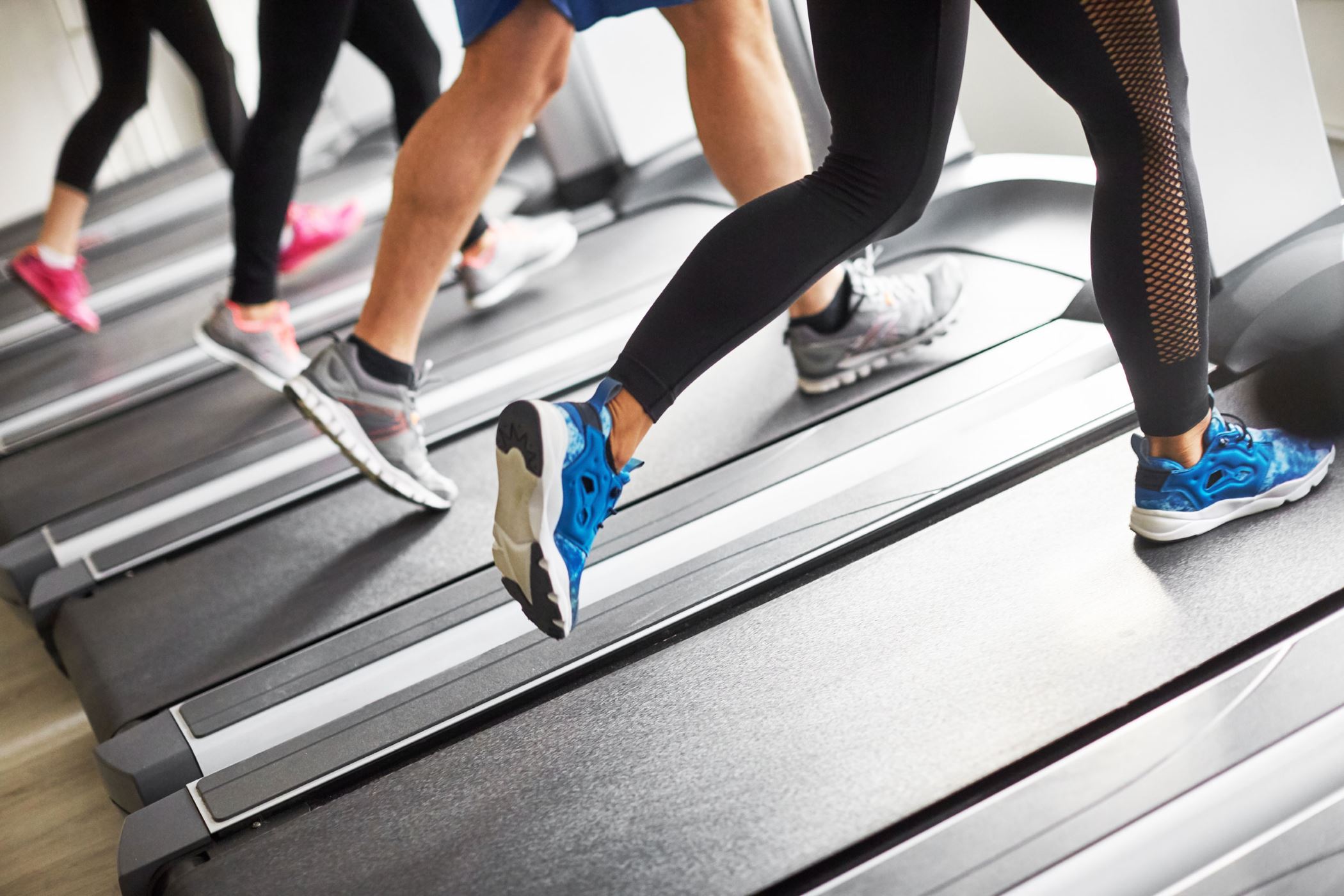

Featured
How To Lose Weight By Jogging
Modified: August 21, 2023
Lose weight and stay fit with our featured jogging program. Discover the benefits of jogging and start your weight loss journey today.
Introduction
Jogging is a popular and effective way to lose weight and improve overall fitness. It is a form of aerobic exercise that can be done by people of all ages and fitness levels. Whether you are just starting your weight loss journey or looking for a new way to enhance your fitness routine, jogging can be a great option. Not only does it offer numerous health benefits, but it can also be a refreshing way to enjoy the outdoors and clear your mind.
When it comes to losing weight, jogging is a natural choice due to its ability to burn calories and boost metabolism. It is a high-impact exercise that engages multiple muscle groups, helping you burn fat and build lean muscle mass. Additionally, jogging can help improve cardiovascular endurance, increase lung capacity, and strengthen bones and joints.
Another advantage of jogging for weight loss is its simplicity and accessibility. You don’t need any expensive equipment or gym memberships – all you need is a pair of comfortable running shoes and a safe place to run. Whether it’s in your neighborhood, a local park, or on a treadmill, jogging can be done anytime and anywhere.
Before diving into a jogging routine, it’s important to set realistic goals and establish a plan. This includes determining how often you want to jog, how long each session will be, and what kind of progress you hope to achieve. It’s also essential to take proper precautions such as warming up, stretching, choosing appropriate gear, and fueling your body with the right nutrition.
In this article, we will explore the benefits of jogging for weight loss, discuss how to set joggin goals, provide tips on warm-up, stretching, and proper technique, offer guidance on choosing the right gear and nutrition, and share advice on staying motivated. By following these guidelines, you can maximize the effectiveness of your jogging workouts and achieve your weight loss goals.
Benefits of Jogging for Weight Loss
Jogging is not only an enjoyable activity but also offers numerous benefits for weight loss. Incorporating regular jogging into your exercise routine can help you shed unwanted pounds and achieve your weight loss goals. Here are some of the key benefits of jogging:
1. Calorie Burning: Jogging is a high-intensity aerobic exercise that helps you burn a significant amount of calories. The number of calories burned depends on factors such as your weight, speed, and duration of jogging. On average, a 30-minute jog can burn anywhere from 200 to 400 calories.
2. Boosts Metabolism: Jogging increases your metabolic rate, which means your body continues to burn calories even after you finish your workout. This is known as the afterburn effect or excess post-exercise oxygen consumption (EPOC). Regular jogging can help boost your metabolism, making it easier to maintain a healthy weight.
3. Muscle Development: Jogging is a weight-bearing exercise that engages multiple muscle groups in your legs, core, and upper body. As you jog, your muscles work to support your body weight, leading to increased muscle tone and strength. Building lean muscle mass can help improve overall body composition and increase your resting metabolic rate.
4. Cardiovascular Health: Jogging is a cardiovascular exercise that strengthens your heart and improves its efficiency. Regular jogging can reduce the risk of heart disease, lower blood pressure, and improve cholesterol levels. By boosting cardiovascular health, jogging contributes to overall well-being and longevity.
5. Stress Reduction: Jogging not only benefits your physical health but also your mental well-being. It is a great way to relieve stress, clear your mind, and improve your mood. The release of endorphins during exercise promotes feelings of happiness and relaxation, reducing anxiety and depression.
6. Accessible and Convenient: Jogging is a versatile and accessible form of exercise. You can do it anywhere and at any time, without the need for expensive equipment or a gym membership. Whether you prefer running outdoors or on a treadmill, jogging offers flexibility and convenience.
7. Social Connection: Jogging can also be a social activity. Joining a running group or finding a jogging buddy can provide motivation, accountability, and the opportunity to connect with others who share similar fitness goals. Exercising with others can make the jogging experience more enjoyable and enjoyable.
By incorporating jogging into your weight loss journey, you can reap these benefits and achieve lasting results. Stay consistent, challenge yourself, and listen to your body to make the most of your jogging workouts. Remember, it’s not just about losing weight, but also about improving your overall health and well-being. So lace up your running shoes and hit the pavement to enjoy the countless benefits of jogging!
Setting Your Jogging Goals
Setting clear and realistic goals is crucial when incorporating jogging into your weight loss journey. These goals will keep you motivated, help track your progress, and ensure that you stay on the right track towards achieving your desired results. Here are some tips for setting effective jogging goals:
1. Be Specific: Define your jogging goals with precision. Instead of simply aiming to “lose weight,” set a specific goal like “I want to jog for 30 minutes nonstop three times a week.” The more specific your goal, the easier it will be to measure your progress.
2. Make it Measurable: Set goals that can be measured to track your progress. This could include tracking the number of miles you jog, the number of minutes you jog each session, or the number of times you jog per week.
3. Be Realistic: When setting your jogging goals, be realistic and consider your current fitness level and schedule. Setting unattainable goals can lead to frustration and disappointment. Start with smaller, achievable milestones and gradually increase the intensity and duration of your jogging sessions.
4. Set a Timeline: Give yourself a timeframe to work towards your goals. This will help create a sense of urgency and keep you accountable. For example, you might set a goal to jog a 5K race within three months or to reach a certain weight within six months.
5. Mix Up Your Goals: Don’t focus solely on weight loss. Consider setting other goals such as improving your jogging speed, increasing your endurance, or participating in a charity run. Having a variety of goals will make your jogging routine more dynamic and enjoyable.
6. Listen to Your Body: Pay attention to how your body feels during and after your jogging sessions. If you experience pain or discomfort, adjust your goals accordingly. It’s important to prioritize your health and well-being.
7. Celebrate Milestones: When you achieve a goal or milestone, celebrate your accomplishment. Reward yourself with something non-food related, such as buying new workout gear or treating yourself to a massage. Celebrating your successes will keep you motivated and encourage you to set new goals.
Remember, goal setting is a personal process, and what works for one person may not work for another. Take the time to reflect on your motivations and aspirations, set goals that align with your values and lifestyle, and be flexible in adjusting them as needed. By setting realistic and meaningful jogging goals, you will have a clear roadmap to guide you on your weight loss journey and increase your chances of success.
Proper Warm-Up and Stretching
Before you start your jogging session, it’s essential to properly warm up and stretch your muscles. A proper warm-up prepares your body for the physical demands of jogging, reduces the risk of injury, and improves performance. Here are some important tips for warming up and stretching before your jog:
1. Start with Dynamic Warm-Up: Begin your warm-up with dynamic exercises to increase your heart rate and loosen up your muscles. Examples include jogging in place, high knees, butt kicks, leg swings, and arm circles. Aim for 5-10 minutes of dynamic warm-up movements.
2. Focus on Key Muscle Groups: Pay attention to the major muscle groups involved in jogging, such as the calves, hamstrings, quadriceps, hips, and glutes. Perform specific dynamic stretches that target these areas to improve flexibility and range of motion.
3. Incorporate Light Cardio: After your dynamic warm-up, engage in light cardio activities such as brisk walking or slow jogging to gradually increase your heart rate and body temperature. This will further prepare your body for the more intense jogging session.
4. Stretch After Your Warm-Up: Once you have elevated your heart rate and body temperature, it’s time to move on to static stretches. Focus on stretching the muscles you will primarily use during jogging, holding each stretch for 15-30 seconds. Key stretches include calf stretches, hamstring stretches, quadriceps stretches, and hip flexor stretches.
5. Listen to Your Body: Pay attention to any discomfort or tightness during your warm-up and stretching routine. Adjust the intensity or duration of your stretches to avoid straining or overstretching your muscles. Never push through pain or discomfort.
6. Gradually Build Intensity: Progressively increase the intensity of your warm-up and stretching routine as you become more comfortable and flexible. Over time, you may incorporate more challenging dynamic movements and deeper static stretches.
7. Make it a Habit: Consistency is key. Make warm-up and stretching a routine part of your jogging sessions. Even on days when you feel pressed for time, allocate at least a few minutes for a quick warm-up and some gentle stretching.
Remember, warming up and stretching are essential components of injury prevention and overall performance enhancement. They help increase blood flow to the muscles, improve flexibility, and reduce the risk of muscle strains or sprains. By incorporating a proper warm-up and stretching routine into your jogging sessions, you’ll be able to enjoy a safer and more effective workout.
Creating a Jogging Schedule
Creating a consistent jogging schedule is essential for making progress in your weight loss journey and improving your overall fitness. Having a plan in place will help you stay accountable, track your progress, and ensure that you are incorporating enough jogging sessions into your week. Here are some useful tips for creating an effective jogging schedule:
1. Set Realistic Goals: Before scheduling your jogging sessions, determine how many days per week you can commit to jogging. Be realistic about your other time commitments and make sure to leave rest days for recovery.
2. Start Slowly: If you’re new to jogging or have been inactive for a while, it’s important to start slowly and gradually increase your jogging frequency. Begin with 2-3 days per week and gradually build up to 4-5 days as your fitness level improves.
3. Mix Up Your Sessions: Vary the duration and intensity of your jogging sessions throughout the week. Incorporate shorter, faster-paced runs for speed and endurance, as well as longer, slower-paced runs for endurance and fat burning.
4. Consider Your Schedule: Take into account your daily routine and find the best time for your jogging sessions. Some people prefer to jog in the morning to kickstart their day, while others find it more convenient to jog in the evening. Choose a time that works best for you and stick to it.
5. Plan Rest Days: Rest days are just as important as jogging days. They allow your body to recover and prevent overuse injuries. Choose one or two days a week for complete rest or low-impact activities such as walking or yoga.
6. Be Flexible: Life can be unpredictable, so be flexible with your jogging schedule. If you miss a jog due to unforeseen circumstances, don’t get discouraged. Adjust your schedule and make up for it on another day.
7. Gradually Increase Intensity: As your fitness level improves, gradually increase the intensity of your jogging sessions. This can be achieved by increasing your speed, adding intervals or hill training, or extending your distance.
8. Keep Track of Your Progress: Use a journal, app, or fitness tracker to record your jogging sessions, including the distance covered, time spent, and perceived effort level. Tracking your progress will help you stay motivated and assess your improvement over time.
9. Listen to Your Body: Pay attention to how your body feels during and after your jogging sessions. If you experience excessive fatigue, muscle soreness, or pain, adjust your schedule to allow for more recovery time.
10. Make it Enjoyable: Make your jogging schedule enjoyable by exploring different routes, listening to music or podcasts, or finding a jogging buddy to keep you motivated.
Creating a jogging schedule that works for you will help make jogging a consistent part of your routine. Remember, the most important thing is to find a balance that fits your lifestyle and allows for gradual progress. Stick to your schedule and watch as you become stronger, fitter, and closer to achieving your weight loss goals.
The Basics of Jogging Technique
Proper jogging technique is key to maximizing your performance, preventing injuries, and getting the most out of your workouts. By focusing on the basics of jogging technique, you can improve your efficiency, increase your speed, and reduce the risk of common jogging-related injuries. Here are some essential tips for mastering the basics of jogging technique:
1. Posture: Maintain an upright posture while jogging. Keep your head up, eyes looking forward, and shoulders relaxed. Engage your core muscles to support your spine and minimize unnecessary upper body movement.
2. Arm Position: Bend your elbows at a 90-degree angle and allow your arms to swing naturally back and forth. Avoid crossing your arms in front of your body and swinging them too far across your chest.
3. Footstrike: Aim for a midfoot or forefoot strike when your foot lands on the ground. Avoid striking with your heel, as this can lead to excessive impact and increase the risk of injuries such as shin splints or knee pain.
4. Cadence and Stride Length: Focus on maintaining a steady cadence (steps per minute) of around 160-180. A higher cadence can help reduce the impact on your joints and improve your running efficiency. Instead of trying to take longer strides, aim for quick, light steps.
5. Breathing: Develop a rhythmic breathing pattern that suits your comfort level. Inhale deeply through your nose and exhale through your mouth. Focus on breathing from your diaphragm to maximize oxygen intake.
6. Pace: Start jogging at a comfortable pace that allows you to maintain proper form and conversation. Gradually increase your speed as your fitness level improves, but avoid pushing yourself to the point where your form suffers.
7. Hills: When running uphill, lean slightly forward from your ankles and take shorter strides. Use your arms to generate momentum. When running downhill, maintain control and avoid overstriding to reduce the impact on your knees and shins.
8. Listen to Your Body: Pay attention to any discomfort or pain during your jogging sessions. If something feels off or you experience ongoing pain, adjust your technique or seek guidance from a running professional or physical therapist.
9. Recovery: Include recovery periods in your jogging routine. Alternate jogging with walking or incorporate rest days to allow your muscles to recover and repair.
10. Consistency: Practice your jogging technique consistently. Over time, your body will adapt and become more efficient.
Remember, mastering jogging technique takes time and practice. Be patient with yourself and focus on gradual improvement. By paying attention to your form, you can enhance your jogging experience, reduce the risk of injuries, and enjoy the full benefits of this effective weight loss exercise.
Choosing the Right Jogging Gear
Choosing the right jogging gear is essential for comfort, performance, and injury prevention. The right gear can enhance your jogging experience, protect your body, and help you reach your weight loss goals. Here are some important factors to consider when selecting your jogging gear:
1. Running Shoes: Invest in a good pair of running shoes that provide proper support and cushioning. Look for shoes designed specifically for jogging or running, and choose a style that suits your foot type and running gait. Visit a specialty running store for a professional fitting and expert advice.
2. Comfortable Clothing: Wear moisture-wicking and breathable fabrics that keep you cool and dry during your jog. Opt for lightweight and comfortable clothing that allows for a full range of motion. Avoid cotton, as it can trap moisture and lead to discomfort.
3. Proper Socks: Invest in moisture-wicking socks that provide cushioning and support. Socks made from synthetic materials or merino wool help keep your feet dry and prevent blisters.
4. Reflective Gear: If you jog during low-light conditions, such as early morning or evening, wear reflective clothing or accessories to improve visibility and safety. This can include reflective vests, armbands, or reflective strips on your clothing or shoes.
5. Sports Bra (for Women): Women should choose a supportive and comfortable sports bra that minimizes breast movement during jogging. Look for styles specifically designed for high-impact activities.
6. Headwear and Sunglasses: Protect yourself from the sun and elements with a breathable hat or visor. Sunglasses with UV protection can shield your eyes from harmful rays and reduce glare.
7. Proper Fit: Ensure that all your jogging gear fits well and allows for unrestricted movement. Ill-fitting shoes, clothing, or accessories can lead to discomfort, chafing, or even injuries.
8. Technology: Consider using a fitness tracker, smartwatch, or smartphone app to monitor your jogging distance, pace, and heart rate. These tools can provide valuable data and help you track your progress over time.
9. Hydration Belt or Water Bottle: Stay hydrated during your jogs by carrying a water bottle or using a hydration belt with built-in water storage compartments. Hydration is essential for performance and overall well-being.
10. Weather-Appropriate Gear: Adapt your gear to accommodate various weather conditions. In colder months, layer your clothing to stay warm, and wear a hat and gloves. In hot weather, choose lightweight and breathable fabrics and protect yourself from the sun.
Remember, everyone’s preferences and needs may vary, so choose gear that suits your individual comfort and requirements. Test different options and make adjustments based on your personal experience. By selecting the right jogging gear, you can optimize your performance, stay comfortable and injury-free, and enjoy your jogging sessions to the fullest.
Fueling Your Body with the Right Nutrition
Nutrition plays a vital role in supporting your jogging performance, enhancing your endurance, and aiding in weight loss. Providing your body with the right nutrients before and after your workouts can optimize your energy levels, aid in muscle recovery, and contribute to reaching your weight loss goals. Here are some key nutrition tips to consider:
1. Pre-Workout Fuel: Prioritize high-quality carbohydrates as a fuel source before your jogging sessions. Opt for complex carbohydrates like whole grains, fruits, and vegetables, which provide sustained energy. Avoid heavy meals close to your workout time, as they can cause discomfort.
2. Hydration: Drink enough water throughout the day, and hydrate yourself adequately before, during, and after your jogs. Dehydration can negatively impact your performance and recovery. For longer jogs, consider sports drinks that replenish electrolytes lost through sweat.
3. Protein for Recovery: After your jogging sessions, include a source of lean protein in your post-workout meal or snack. Protein aids in muscle repair and recovery. Good sources include poultry, fish, tofu, beans, Greek yogurt, or protein shakes.
4. Healthy Fats: Incorporate healthy fats into your diet, such as avocados, nuts, seeds, and olive oil. These provide essential fatty acids that support overall health and help with satiety.
5. Vitamins and Minerals: Consume a variety of fruits and vegetables to ensure you get a wide range of vitamins and minerals. These nutrients support immune function, energy production, and overall well-being.
6. Avoid Excess Sugar: Limit your intake of sugary drinks, processed snacks, and desserts. These can provide empty calories and lead to energy crashes and weight gain. Opt for whole foods instead.
7. Timing: Aim to eat a balanced meal containing carbohydrates, protein, and healthy fats 1-3 hours before your jogging session. If you’re short on time, have a small snack, like a banana and a handful of nuts, 30-60 minutes before jogging.
8. Listen to Your Body: Pay attention to how different foods make you feel before, during, and after your jogs. Everyone’s digestion and tolerance levels may vary, so find what works best for you.
9. Meal Planning: Plan your meals and snacks in advance to ensure you have the right nutrition readily available. This prevents relying on unhealthy options due to lack of planning or time constraints.
10. Consult a Professional: If you have unique dietary requirements or specific goals, consider seeking guidance from a registered dietitian or nutritionist who can provide personalized recommendations.
Remember, nutrition is a personal and individualized aspect of your jogging journey. Experiment with different foods, listen to your body, and pay attention to how your nutrition impacts your performance and well-being. By fueling your body with the right nutrition, you’ll optimize your jogging experience, support weight loss, and enhance your overall health and fitness.
Hydration Tips for Joggers
Proper hydration is essential for optimal performance, endurance, and overall well-being, especially for joggers. When you jog, you sweat, and fluid loss can lead to dehydration, which can negatively impact your performance and even your health. To stay hydrated and support your jogging sessions, follow these helpful hydration tips:
1. Drink Water Regularly: Sip water throughout the day to maintain hydration. This is especially important on days when you plan to jog. Aim for at least 8 cups (64 ounces) of water per day, or more if you are engaging in intense exercise or exposed to hot weather.
2. Pre-Hydrate: Drink 16-20 ounces of water 1-2 hours before your jogging session. This helps ensure that you start your jog well-hydrated.
3. During Exercise: Carry a water bottle or utilize hydration stations if available during your jog. Drink 4-8 ounces of water every 15-20 minutes to replenish fluids lost through sweat. Adjust your fluid intake based on factors like intensity, duration, and weather conditions.
4. Consider Electrolytes: For longer and more intense jogs, consider replenishing electrolytes lost through sweat. Electrolytes like sodium, potassium, and magnesium help maintain fluid balance in your body. Look for sports drinks or electrolyte-enhanced water, or replenish electrolytes through natural sources like fruits and nuts.
5. Monitor Urine Color: Pay attention to the color of your urine. If it’s pale yellow or clear, you are adequately hydrated. Darker urine is a sign that you should drink more water.
6. Post-Jog Hydration: After your jog, hydrate to replenish any fluid loss. Drink at least 8 ounces of water within 30 minutes of completing your jog. Pair it with a source of electrolytes or include a snack with water-rich foods like watermelon or cucumber.
7. Listen to Your Thirst: Trust your body’s thirst cues and drink when you feel thirsty. It’s important not to wait until you feel excessively thirsty, as this may indicate dehydration.
8. Avoid Excessive Hydration: While staying hydrated is crucial, overhydrating can lead to a condition called hyponatremia, where your sodium levels become imbalanced. Stick to a moderate and balanced approach to hydration.
9. Incorporate Hydration into Your Routine: Make hydrating a consistent habit. Set reminders to drink water throughout the day and have a water bottle readily available during your jogs. Hydration should be a part of your daily routine, not just during exercise.
10. Consider Environmental Factors: Adjust your hydration needs based on the weather conditions. Hot and humid weather increases sweat and fluid loss, so you may need to drink more water to compensate.
Remember, everyone’s hydration needs may vary based on factors like body size, fitness level, and environmental conditions. It’s important to find the right balance to support your jogging performance and overall health. Pay attention to your body’s signals and make hydration a priority to stay well-hydrated before, during, and after your jogging sessions.
Avoiding Common Mistakes while Jogging
Jogging is a fantastic activity for weight loss and overall fitness, but it’s important to avoid common mistakes that can hinder your progress or lead to injury. By being mindful of these mistakes and making necessary adjustments, you can enhance your jogging experience and maximize your results. Here are some common mistakes to avoid while jogging:
1. Starting Too Fast: One of the most common mistakes is starting your jog at an unsustainable pace. Avoid the temptation to push yourself too hard in the beginning. Start with a comfortable pace and gradually increase your speed and intensity over time.
2. Skipping Warm-Up and Stretching: Neglecting to warm up and stretch can increase the risk of muscle strain and injury. Always spend a few minutes warming up with dynamic exercises and perform static stretches for key muscle groups before starting your jogging session.
3. Ignoring Proper Form: Running with incorrect form can lead to inefficient movement and increased risk of injury. Focus on maintaining good posture, a slight forward lean, relaxed shoulders, and a midfoot or forefoot strike. Engage your core and swing your arms naturally.
4. Overtraining: Pushing yourself too hard without allowing for proper rest and recovery can lead to overuse injuries and burnout. Incorporate rest days into your jogging schedule and listen to your body’s signals, making adjustments as needed.
5. Not Varying Your Workouts: Repeating the same jogging routine can lead to stagnation and boredom. Incorporate variety into your workouts by changing your routes, incorporating intervals or hills, or trying different types of running surfaces.
6. Not Listening to Your Body: Pay attention to any signals of pain, discomfort, or fatigue during your jogs. Ignoring these signs can lead to more serious injuries. If something doesn’t feel right, adjust your training or consult a medical professional.
7. Improper Hydration: Failing to hydrate adequately before, during, and after your jogs can affect your performance and overall well-being. Follow proper hydration practices to maintain optimal fluid balance.
8. Neglecting Strength Training: Jogging alone may not be sufficient for overall fitness and weight loss. Include regular strength training workouts to build muscle, increase metabolism, and prevent imbalances.
9. Wearing the Wrong Gear: Wearing improper or ill-fitting shoes, clothing, or accessories can lead to discomfort or injury. Invest in appropriate jogging gear, including supportive running shoes that suit your foot type and comfortable moisture-wicking clothing.
10. Not Tracking Progress: Failing to track your progress can make it difficult to assess your improvement and stay motivated. Keep a record of your jogging sessions, including distance, time, and perceived effort, to see how far you’ve come.
By avoiding these common jogging mistakes, you can improve your performance, reduce the risk of injury, and make the most of your weight loss journey. Remember to take it at your own pace, listen to your body, and prioritize sustainability for long-term success.
Monitoring Your Progress and Adjusting Your Plan
Monitoring your progress is key to staying motivated, tracking your achievements, and making necessary adjustments to your jogging plan. By keeping a close eye on your performance and regularly evaluating your progress, you can ensure that you are on track towards your weight loss goals. Here are some tips for monitoring your progress and adjusting your plan accordingly:
1. Set Measurable Goals: Establish specific and measurable goals that you can track over time. Whether it’s improving your jogging speed, increasing your distance, or reaching a target weight, having clear goals will give you something to strive for.
2. Keep a Running Log: Maintain a record of your jogging sessions, including the distance covered, time taken, and perceived exertion level. A running log allows you to track your progress and identify patterns of improvement or areas for adjustment.
3. Use a Fitness Tracker: Consider using a fitness tracker or smartphone app to monitor your running metrics, such as pace, distance, and heart rate. These devices provide real-time feedback and help you analyze your performance.
4. Track Weight Loss: If weight loss is one of your goals, regularly measure and record your weight. Track your progress over time to assess whether your jogging and nutrition plan is effectively contributing to your weight loss journey.
5. Assess Performance Metrics: Periodically evaluate your performance metrics, such as pace and endurance. Look for improvements in your running times or the ability to sustain a faster pace for longer durations.
6. Listen to Your Body: Pay attention to how your body feels during and after your jogging sessions. Notice any changes in energy levels, muscle soreness, or overall well-being. This awareness can help you determine if you are pushing too hard or need to adjust your training.
7. Consider Professional Advice: If you are facing challenges or need guidance, consult with a running coach or fitness professional. They can provide insights, suggest modifications, and offer strategies to overcome plateaus or barriers.
8. Periodize Your Training: Consider incorporating periodization into your jogging plan by alternating between different phases of training. This approach allows for variations in intensity, volume, and focus, which can help prevent burnout and optimize progress.
9. Adjust Frequency and Intensity: Be flexible and open to adjusting the frequency and intensity of your jogging sessions. Gradually increase the number of jogs per week or modify the duration and intensity of each session as your fitness level improves.
10. Celebrate Milestones and Rewards: Celebrate your achievements and milestones along the way. Treat yourself to rewards when you reach significant goals to maintain motivation and reinforce positive habits.
Regularly monitoring your progress and making necessary adjustments to your jogging plan is essential for long-term success. Embrace the journey, stay consistent, and use the valuable data and insights you gather to keep yourself motivated and on the path to achieving your weight loss goals.
Staying Motivated on Your Weight Loss Journey
Embarking on a weight loss journey requires commitment, dedication, and consistent effort. However, it’s common to encounter challenges and moments of wavering motivation along the way. To stay motivated and focused on your weight loss goals, consider the following strategies:
1. Set Realistic and Achievable Goals: Set goals that are specific, measurable, attainable, relevant, and time-bound (SMART goals). Break down your weight loss goal into smaller milestones to celebrate incremental successes.
2. Visualize Success: Create a mental image of yourself achieving your weight loss goals. Visualizing success can boost motivation and keep you focused on the long-term benefits of your efforts.
3. Find Your Why: Identify your reasons for wanting to lose weight. Whether it’s improving your health, increasing your energy levels, or boosting self-confidence, understanding your “why” will help sustain your motivation.
4. Track Your Progress: Keep a record of your weight loss, measurements, and fitness achievements. This tangible evidence of progress can serve as a powerful motivator and a reminder of how far you’ve come.
5. Seek Support: Surround yourself with a support system of friends, family, or like-minded individuals who can encourage and motivate you throughout your weight loss journey. Joining a fitness community or participating in group activities can provide additional accountability and inspiration.
6. Reward Yourself: Celebrate your accomplishments by setting up rewards for reaching specific milestones. Treat yourself to non-food rewards such as new workout gear, a massage, or a weekend getaway. Reinforcing positive behavior can help maintain motivation.
7. Mix Up Your Workouts: Avoid monotony by incorporating variety into your exercise routine. Try different forms of physical activity, such as cycling, swimming, or group fitness classes. This not only prevents boredom but also challenges your body in new ways.
8. Set Small, Consistent Goals: Break your weight loss journey into smaller, manageable goals. Focus on making sustainable changes to your eating habits and exercise routine. Small, consistent progress is more sustainable and will keep you motivated for the long term.
9. Track Non-Scale Victories: Don’t solely rely on the number on the scale to measure your progress. Notice and celebrate non-scale victories, such as increased endurance, improved sleep quality, or fitting into smaller clothing sizes.
10. Practice Self-Compassion: Be kind to yourself during your weight loss journey. Embrace imperfections, acknowledge setbacks, and maintain a positive mindset. Remember that progress is not always linear, and every small step forward counts.
11. Visual and Written Affirmations: Create affirmations or statements that reflect your weight loss goals and positive self-image. Display them in visible areas or write them in a journal to remind yourself of your aspirations on a daily basis.
12. Regularly Reassess and Adjust: Periodically review your goals and assess your progress. Adjust your plan, if necessary, to keep challenging yourself and maintain your motivation.
Remember, maintaining long-term motivation is a journey in itself. Embrace the process, be patient with yourself, and celebrate every step forward. By implementing these strategies, you can stay motivated and empowered on your weight loss journey.
Conclusion
Jogging can be a powerful tool for weight loss, improved fitness, and overall well-being. By incorporating the tips and strategies discussed in this article, you can make jogging a sustainable and effective part of your weight loss journey. Remember to start with realistic goals, warm up and stretch properly, choose the right gear, fuel your body with the right nutrition, and stay hydrated. Avoid common mistakes, consistently monitor your progress, and stay motivated by celebrating milestones and seeking support.
It’s important to approach jogging with patience, listening to your body, and making adjustments as needed. Everyone’s weight loss journey is unique, so find what works best for you and stay committed to your goals. Embrace the process, enjoy the benefits of jogging, and allow yourself to be proud of the progress you make along the way.
Remember, weight loss is a lifelong journey that requires consistent effort and lifestyle changes. Jogging can provide a valuable tool in your arsenal to not only lose weight but also improve your physical fitness, mental well-being, and overall quality of life. So, lace up your running shoes, hit the pavement, and let jogging become a rewarding and transformative part of your weight loss journey.









